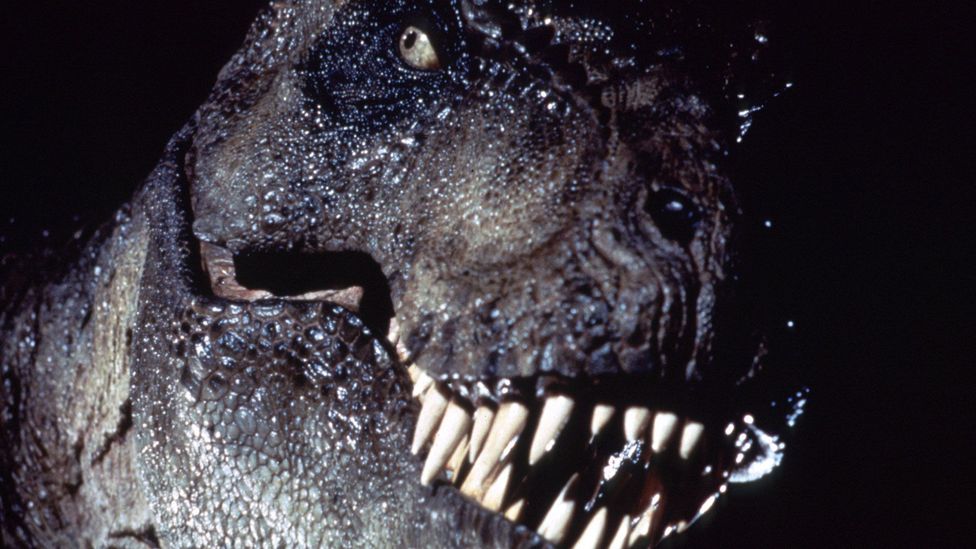
Released 30 years ago, Jurassic Park is both an action blockbuster and a terrifying horror, writes Gregory Wakeman. He finds out how Steven Spielberg made scary movies accessible for younger children.
O
On 11 June 1993, Hollywood changed forever. Jurassic Park was unleashed into US cinemas, and its impact on the movie industry sill reverberates to this day – from the studios competing to buy the rights to Michael Crichton’s 1990 novel about a theme park full of genetically recreated dinosaurs, to the marketing and mass-release strategy that helped make it the highest grossing film ever at the time. Not to forget its innovative use of visual effects.
More like this:
– The 1983 film decades ahead of its time
– The 1998 film that predicted the future
– David Lynch on ‘the beauty in the dark’
First and foremost, though, Jurassic Park is an incredible feat of blockbuster filmmaking. Which is hardly a surprise since it was made by Steven Spielberg, the man who helped to pioneer the genre with the likes of Jaws, Raiders of the Lost Ark, and ET the Extra-Terrestrial. “Jurassic Park is quintessential Spielberg,” says Susan Goldman Rubin, the author behind Steven Spielberg: Crazy for Movies. “This is the movie he would have liked to have seen when he was a boy.”
Which makes it all the more surprising that, as well as being a rip-roaring blend of science-fiction, action and adventure, Jurassic Park is basically a horror film, too. For many viewers of a certain age, Jurassic Park was the most terrifying and traumatic movie experience of their childhood.
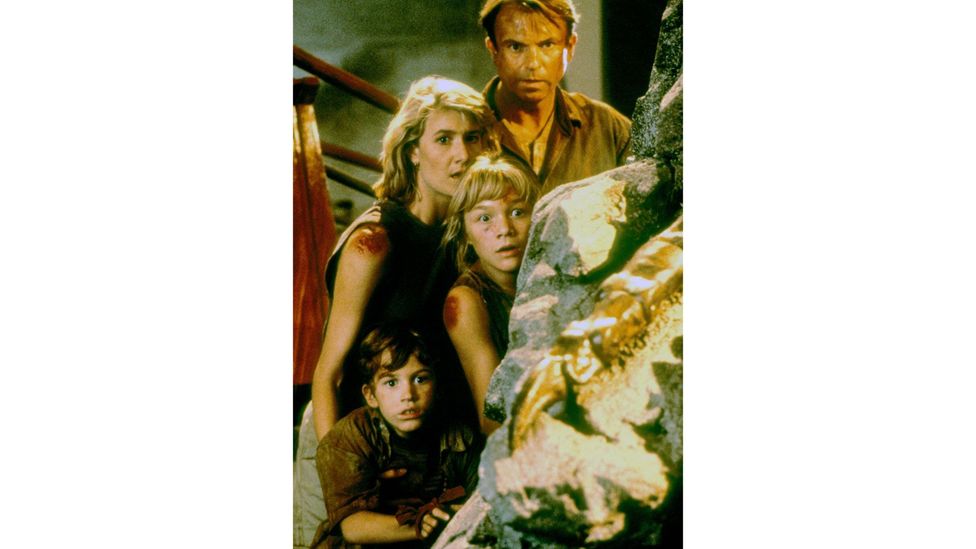
Jurassic Park combined tension with jump-scares to create a film that terrified (Credit: Alamy)
Straight from the get-go, Jurassic Park’s opening scene depicts a seemingly contained raptor smartly moving her cage to kill one of her transporters. The audience then gets to see a T-Rex eating a “bloodsucking lawyer” off a toilet whole, while the raptors feed on a cow, trick the experienced hunter Robert Muldoon before munching on him face first, and also come increasingly close to mauling two children at various points. There’s also Mr Arnold (Samuel L Jackson)’s severed arm.
Sowing fear
“Jurassic Park definitely has horror elements to it. Students always tell me they saw it as a kid and it scared them witless,” says James Kendrick, a professor of film and digital media at Baylor University and author of Darkness in the Bliss-Out: A Reconsideration of the Films of Steven Spielberg. This has been a trait throughout Spielberg’s career, he insists.
“In the summer of 1984, it was the release of Indiana Jones and the Temple of Doom and Gremlins, which he directed and produced respectively, that pushed to the creation of the PG-13 rating. He also garnered controversy with Jaws. That was released with a special addendum to the rating, because audiences thought it would be too intense for younger children. He’s always made scary movies that are accessible to younger children.”
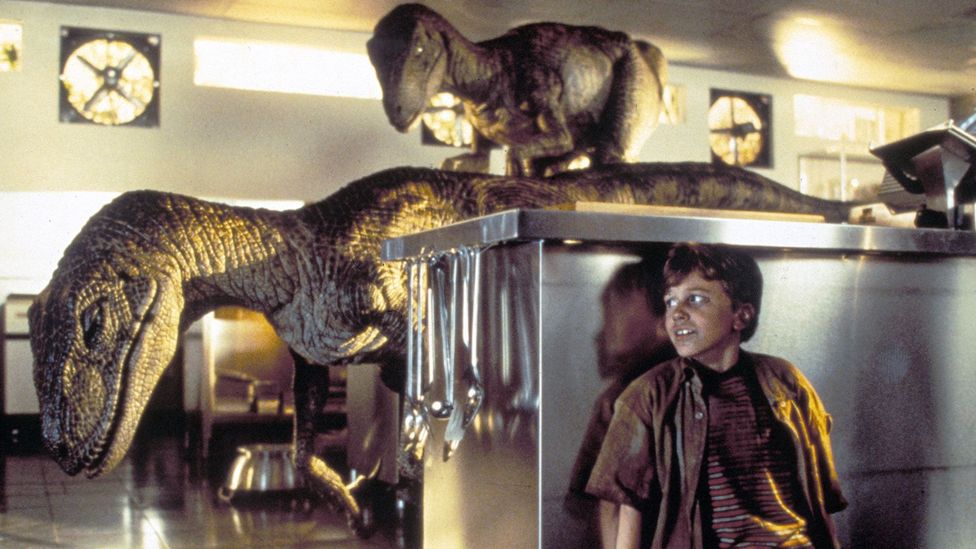
Like Jaws, Jurassic Park built tension before exploding in a set-piece (Credit: Alamy)
This is one of the reasons why Spielberg was initially approached to adapt Jurassic Park. Even he noticed the similarities between Crichton’s novel and his 1975 classic Jaws. Both are about creatures causing chaos for humans and man’s arrogance when it comes to dealing with them and nature, while the films’ set-pieces initially build in a slow and increasingly tense manner before violence and death unfolds.
It’s like he’s teasing you in the same way he did with Jaws, where he showed you the fin – James Kendrick
At first these connections made Spielberg think that he shouldn’t direct the 1993 blockbuster. “Spielberg had a bit of a misgiving about directing Jurassic Park. He referred to it as Jaws on land,” recalls Joseph McBride, who wrote Steven Spielberg: A Biography. Ultimately, he decided to tackle Jurassic Park because it presented him with a “different set of physical realities to play with”, says McBride. “That’s part of the secret of the movie. It works on a physical and visceral level.”
The parallels between Jaws and Jurassic Park are most apparent in their opening scenes. “In both he just gives you hints of the shark and the velociraptors,” says Kendrick. “You hear them, see a flash of their eyes, the crate moving. It’s like he’s teasing you in the same way he did with Jaws, where he showed you the fin. He’s showing people getting attacked, not what’s attacking them.”
Hitchcockian suspense
When it comes to Jurassic Park’s most famous sequence, Spielberg spends as much time ratcheting up the tension as he does on the T-Rex trying to pry Tim (Joseph Mazzello) and Lex Murphy (Arian Richards) out of their jeep so she can eat them. Not only do we see that the electricity has been turned off on the fence keeping her out, but the goat disappears, and, most iconically of all, the water vibrates as the T-Rex gets closer to escaping the paddock.
“He’s building up the fear almost like Alfred Hitchcock,” notes Rubin. “The anticipation is sometimes worse than the real thing. That’s what Spielberg does so brilliantly. He watched Hitchcock work when he was an intern at Universal. He absorbed so much like a sponge.”
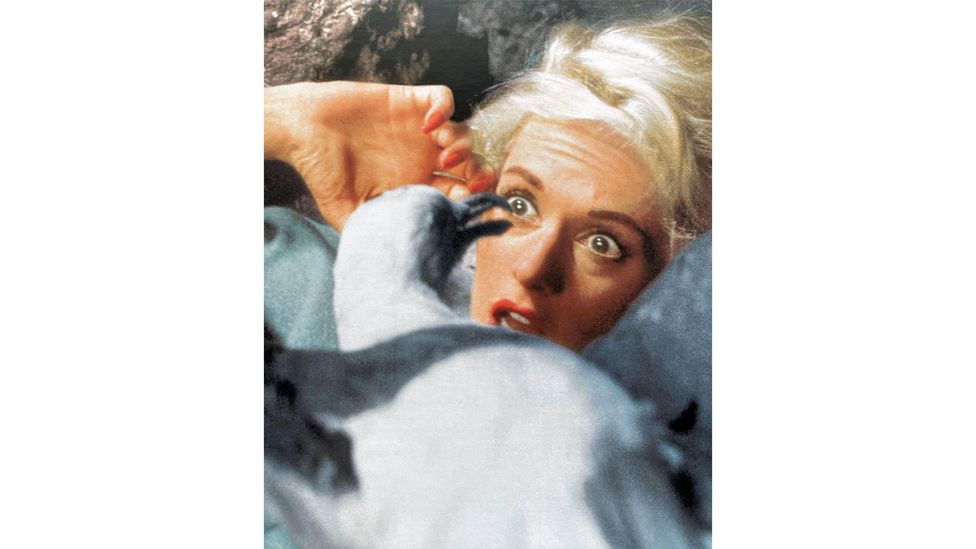
Spielberg took inspiration from Hitchcock, a master of creating anticipation in films like The Birds (Credit: Alamy)
But it wasn’t just his own work as a director on Jaws, it was Hitchcock’s films like The Birds and North by Northwest, and Spielberg’s long fascination with science-fiction and monster movies that influenced Jurassic Park. Rubin believes that the film was another attempt by Spielberg to “overcome his own fears by scaring others”.
During the process of writing Steven Spielberg: Crazy For Movies, Rubin became close friends with Spielberg’s mother, Leah, who opened up to her about Steven as a youngster. “He was so frightened of everything as a child,” Rubin explains. “He was afraid of water, the wind, dark clouds. He’d have nightmares every night. To overcome those fears, he would tell his sisters ghost stories to frighten them.”
With Jurassic Park, Spielberg continued his tradition of using fear to both frighten and impact children. “Scholars have said that children respond to frightening stories the most. If they’re done well, they’re welcomed by children and it helps to make them more resilient,” says McBride. This also explains why Spielberg movies regularly have children as their main characters, or at the very least have sequences from their point of view.
“Putting kids in danger immediately amplifies and raises the stakes of a movie,” says Kenilworth. “Because in the back of your mind you’re always thinking, ‘He’s not going to kill a child… is he?” The problem with this is that Spielberg had no issue killing 12-year-old boy Alex Kinter in Jaws. Kenilworth believes this influenced audiences when watching Jurassic Park, as they subconsciously remembered that and then thought, “Maybe these kids aren’t as safe we like to think they are.”
He has the entertainer side and the serious side. He would always make a darker film and then a lighter film. It helped to keep him balanced – Joseph McBride
Spielberg’s ability to seamlessly weave between dark and light material is best summed up by the fact that, at the same time as he was working on the visual effects for Jurassic Park by night, he was directing Schindler’s List in the day. The World War Two drama about businessman Oskar Schindler’s efforts to save Jews from the Nazis was released six months after Jurassic Park, and went on to win seven Academy Awards, including best picture and best director for Spielberg.
“He’s had conflicting impulses throughout his career. He has the entertainer side and the serious side. He would always make a darker film and then a lighter film. It helped to keep him balanced. He has such great versatility,” says McBride. This wasn’t without a personal cost, though. Spielberg was so emotionally drained by working on these two movies at the same time that there was a four-year gap until his next film after Schindler’s List. This so happened to be the sequel to Jurassic Park, 1997’s The Lost World: Jurassic Park.
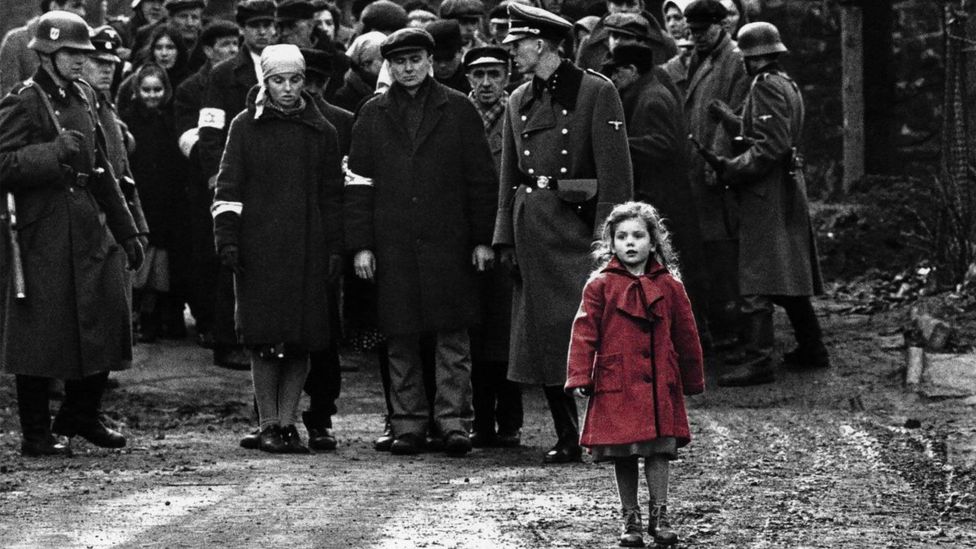
Spielberg has always combined light and dark, filming Schindler’s List between his two Jurassic Park movies (Credit: Alamy)
Even that film is linked to Jaws. After the monster success of Jaws, Spielberg was offered the chance to make a sequel, which he was actually tempted to do. The studio weren’t interested in his suggestions for the next instalment, though, so Spielberg declined. “He let other people do the sequels,” says McBride. “But then he felt bad because they were lousy. He felt protective of Jurassic Park, so he decided to make The Lost World.”
The Lost World failed to even match the box office of its predecessor, while it was also widely admonished by critics. The four subsequent additions to the franchise haven’t fared much better. Such is the genius of Jurassic Park, these below-par follow-ups haven’t damaged its legacy. Now it is regarded as the film that kick-started Hollywood’s reliance on visual effects.
Which makes it all the more surprising then that there are only 63 computer-generated effects in Jurassic Park, and it contains just six minutes of CGI dinosaurs. Instead, Spielberg used life-sized animatronic dinosaurs built by Stan Winston and his team, as well as his filmmaking acumen, to spellbind and captivate viewers.
“Jurassic Park is an incredible example of showing audiences exactly the right amount when you need to see it for maximum effectiveness,” remarks Kenilworth. “Another director might not have been able to get away with showing so few dinosaurs. But Spielberg’s track record meant that they trusted him.”
Unfortunately, when it comes to the use of visual effects, Spielberg’s approach of less-is-more hasn’t been followed by modern blockbusters. “A lot of modern action sequences are just mayhem,” says McBride. “Like Scorsese said a few years ago, the super-fast cutting disorients the viewer. It’s an assault on our consciousness to have images just smashing into each other from all different kinds of angles and not knowing where you are. With Spielberg, you always know where you are. He believes in characters and story. He knows that’s what matters and what is important.”
Love film and TV? Join BBC Culture Film and TV Club on Facebook, a community for cinephiles all over the world.
If you would like to comment on this story or anything else you have seen on BBC Culture, head over to our Facebook page or message us on Twitter.
And if you liked this story, sign up for the weekly bbc.com features newsletter, called The Essential List. A handpicked selection of stories from BBC Future, Culture, Worklife and Travel, delivered to your inbox every Friday.
;





